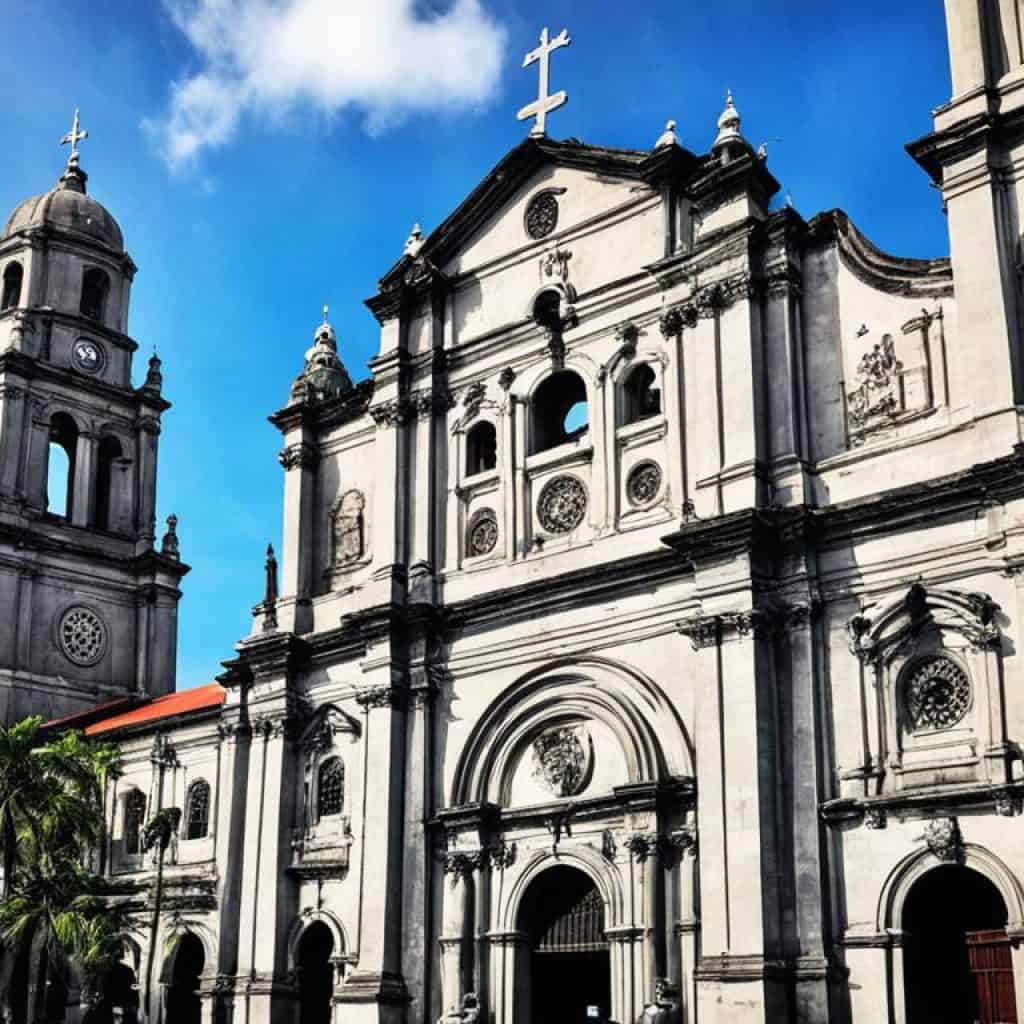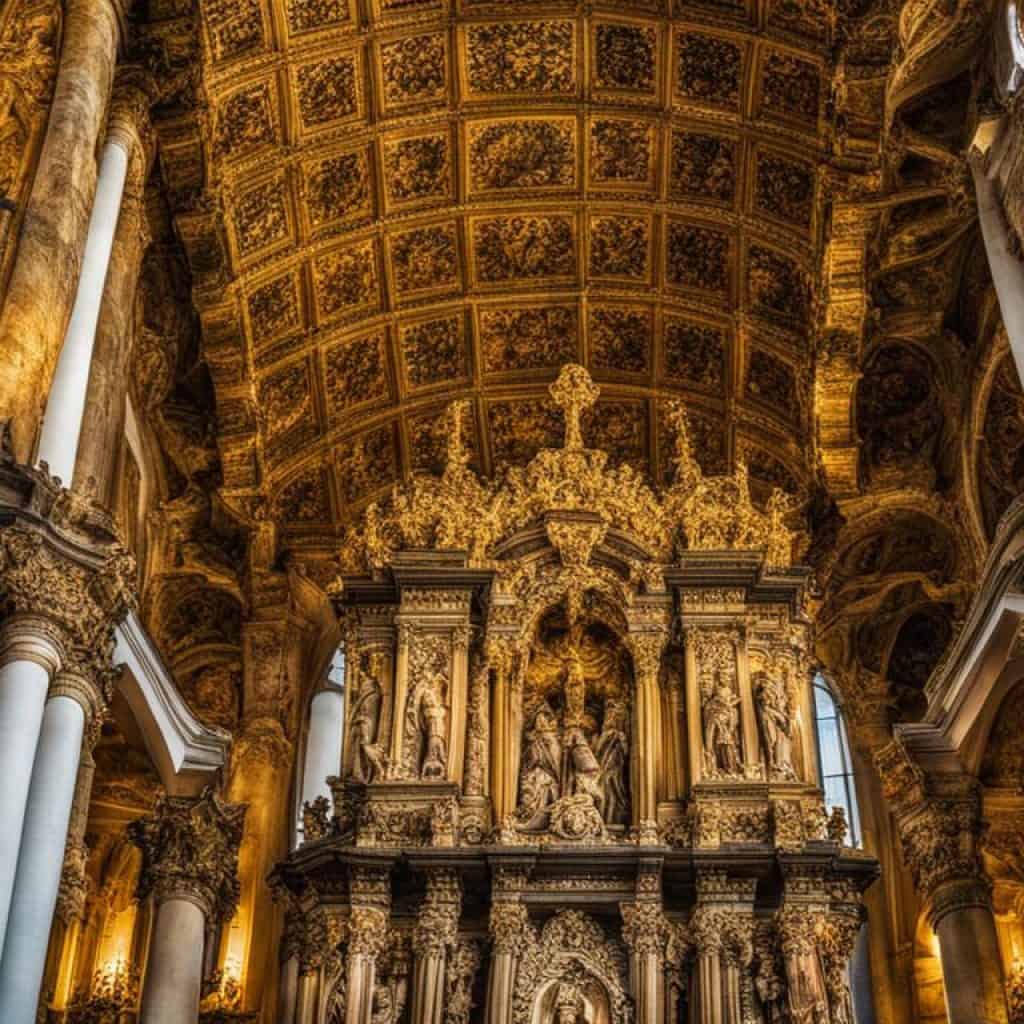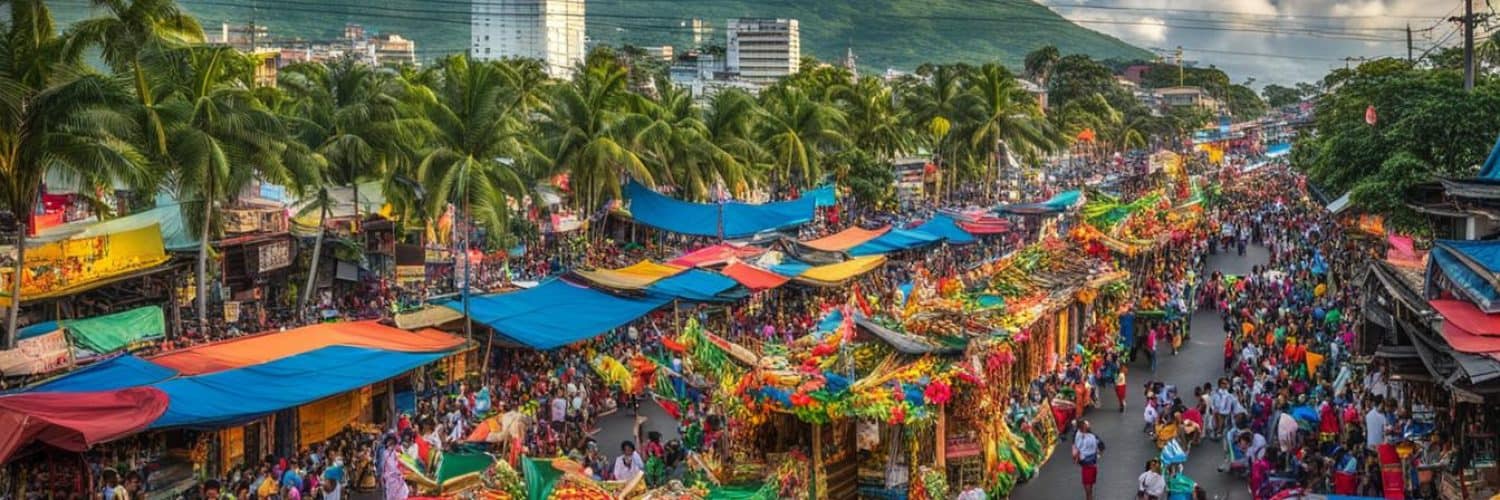Have you ever wondered about the diverse and captivating culture of the Philippines? From the unique Filipino cultural practices to the vibrant traditional Filipino celebrations, the country’s cultural heritage is truly fascinating. But what are some examples of culture in the Philippines? How do these traditions shape the identity of its people? Join us as we delve into the rich tapestry of customs, arts, and traditions that define the cultural heritage in the Philippines.
Key Takeaways:
- The cultural heritage in the Philippines is diverse and rich.
- Filipino cultural practices and traditional celebrations play a significant role in shaping the country’s identity.
- Exploring the cultural heritage in the Philippines offers a glimpse into the unique and captivating aspects of Filipino life.
- The cultural traditions in the Philippines reflect its history, influences, and indigenous cultures.
- From the Prehispanic era to the modern times, the culture of the Philippines is a treasure trove waiting to be discovered.
The Prehispanic Philippines: A Key Player in Human Evolution
The Prehispanic Philippines played a pivotal role in shaping our understanding of human evolution. Recent discoveries have challenged long-held beliefs about ancient human migration and shed light on early human habitation in this region. These findings have brought attention to the presence of multiple human species, such as Homo floresiensis, and raised exciting questions about the diversity of hominins in the Philippines.
A significant factor that contributed to the complexity of human evolution in the Prehispanic Philippines is its maritime capabilities. Ancient Filipinos possessed impressive sailing skills, enabling them to navigate the vast archipelago and establish connections across different islands. This maritime prowess facilitated cultural exchanges between various communities, fostering the development and transmission of ideas, technologies, and traditions.
Through these cultural exchanges, the Prehispanic Philippines became a melting pot of diverse influences, contributing to the rich tapestry of the region’s cultural heritage. The interactions between different groups not only shaped the social and cultural dynamics of ancient societies but also left a lasting impact on subsequent generations.
“The Prehispanic Philippines stands as a testament to the remarkable resilience and adaptability of early human populations. It is a fascinating chapter in our shared human story that continues to unfold through archaeological research and scientific advancements.” – [Insert Name], Archaeologist
The Prehispanic Philippines is an invaluable treasure trove for researchers, providing valuable insights into the complexities of human evolution. By studying the ancient human migration patterns, exploring the presence of multiple human species, and unraveling the maritime capabilities and cultural exchanges of the region, we can piece together a more comprehensive understanding of our shared origins and the remarkable journey of human evolution.
Examples of Cultural Exchanges in the Prehispanic Philippines:
- Ancient trade networks: The Prehispanic Philippines served as a crucial hub in regional trade networks, connecting Southeast Asia with East Asia and beyond. This enabled the exchange of goods, ideas, and cultural practices.
- Influence of neighboring cultures: The proximity of the Philippines to various neighboring cultures, such as China, India, and Indonesia, resulted in the assimilation of external influences into local traditions, arts, and belief systems.
- Shared mythology and folklore: Cultural exchanges fostered the development of shared mythologies and folklore, reflected in the remarkable similarities found in the origin stories and legends across various indigenous Filipino groups.
These cultural exchanges in the Prehispanic Philippines not only shaped the identity of the archipelago’s diverse communities but also contributed to the broader tapestry of human culture and civilization.
| Key Factors | Impact on Human Evolution |
|---|---|
| Ancient human migration | Revealed new insights into migration patterns and early human habitation in the region. |
| Multiple human species | Raised questions about the diversity of hominins in the Philippines and their interactions with other human species. |
| Maritime capabilities | Facilitated cultural exchanges, leading to the transmission and integration of ideas, technologies, and traditions. |
| Cultural exchanges | Contributed to the rich tapestry of the region’s cultural heritage and influenced subsequent generations. |
Exploring Intramuros: A Glimpse into Manila’s Colonial Past
Discover the fascinating history and cultural heritage of Intramuros, a captivating district in Manila that offers a window into the Philippines’ colonial past. Also known as the Walled City, Intramuros was established by the Spanish in the 16th century and is surrounded by imposing walls that tell tales of a bygone era.
One of the iconic landmarks within Intramuros is Fort Santiago, a fortress that holds great historical significance. This well-preserved structure played a significant role in the life of one of the nation’s heroes, Jose Rizal. Immerse yourself in the ambiance of Fort Santiago and relive the pivotal moments that shaped the nation’s fight for independence.
As you stroll through the narrow streets and cobblestone pathways of Intramuros, you’ll encounter remnants of the Spanish colonial era that bear witness to the rich cultural tapestry of Manila. Delve into the charming Spanish-style architecture and explore the various museums and landmarks that offer a deeper understanding of the city’s heritage.
Whether you’re visiting the Casa Manila Museum to get a glimpse of a colonial lifestyle, admiring the stunning San Agustin Church with its intricate baroque architecture, or simply wandering the streets to absorb the atmosphere, Intramuros promises an enriching cultural experience.

Let the walls of Intramuros transport you to a different time and place, allowing you to appreciate the historical significance and architectural beauty of this unique district. Lose yourself in the stories that unfold within Intramuros, and gain a newfound appreciation for Manila’s colonial past.
The Legacy of Dr. Jose Rizal at Rizal Park
Rizal Park, also known as Luneta Park, is an expansive green space adjacent to Intramuros that serves as a monument to the life and works of Dr. Jose Rizal, the Philippines’ national hero. The park showcases the Rizal Monument, a symbol of Filipino patriotism and identity.
“The youth is the hope of our future.”
Rizal Park not only offers a tranquil oasis in the heart of Manila but also provides insights into the nation’s history and the legacy of Dr. Jose Rizal. With its lush gardens and impressive structures, the park is a testament to the enduring Filipino spirit and the pursuit of freedom. It is a place where visitors can connect with the ideals and values that Dr. Jose Rizal stood for, such as love for country, education, and social justice.
| Key Features of Rizal Park | Description |
|---|---|
| Rizal Monument | A towering bronze monument dedicated to Dr. Jose Rizal, featuring his statue and an obelisk. |
| Rizal Walk and Orchidarium | A serene pathway surrounded by beautifully landscaped gardens and an orchidarium, offering a peaceful retreat. |
| Burnham Green | A wide open space ideal for picnics, outdoor activities, and cultural events. |
| National Museum of the Philippines | Located within Rizal Park, the museum houses a vast collection of art, archaeology, and ethnography. |
Visitors to Rizal Park can explore the various attractions and immerse themselves in the historical significance of the park. The serene atmosphere, combined with the awe-inspiring monuments, creates a profound appreciation for the national hero and his contribution to Filipino patriotism and unity.
Manila Ocean Park: A Magical Marine Adventure
Manila Ocean Park is a marine-themed attraction that offers an enchanting journey into the wonders of marine life. This state-of-the-art aquarium is a must-visit destination in Manila, where visitors can explore a fascinating world beneath the waves.

Step into Manila Ocean Park and be mesmerized by a breathtaking display of marine life. From vibrant coral reefs teeming with colorful fish to playful dolphins showcasing their acrobatic skills, the park offers a captivating experience for visitors of all ages.
The highlight of Manila Ocean Park is its stunning oceanarium tunnel. As you walk through the tunnel, you’ll be surrounded by the beauty of an underwater world, with marine creatures swimming gracefully above and around you. It’s a truly immersive experience that will leave you in awe.
But Manila Ocean Park is not just a place for entertainment; it’s also an educational hub. The park features interactive shows and exhibits that provide valuable insights into the marine ecosystem and the importance of conservation. Visitors can learn about the different species that inhabit the ocean and the challenges they face in their natural habitats.
Whether you’re a marine enthusiast or simply looking for a fun and educational day out with your family, Manila Ocean Park is the perfect destination. Immerse yourself in the beauty of the underwater world and gain a deeper appreciation for the wonders of marine life.
Experience the Wonders of Manila Ocean Park:
- Explore vibrant coral reefs and witness the diversity of marine species
- Watch captivating dolphin and sea lion shows
- Walk through the spectacular oceanarium tunnel for an immersive underwater experience
- Engage in interactive exhibits and learn about marine conservation
- Enjoy a fun-filled day with family and friends
| Attractions | Showtimes | Location |
|---|---|---|
| Dolphin Show | 10:00 AM, 2:00 PM | Aquatica Stadium |
| Sea Lion Show | 11:00 AM, 3:00 PM | Sea Lion Point |
| Oceanarium Tunnel | Open All Day | Main Building |
| Interactive Exhibits | Open All Day | Main Building |
“Manila Ocean Park is a captivating marine-themed attraction that provides both entertainment and education. Immerse yourself in the wonders of the underwater world and gain a deeper appreciation for marine life and conservation.”
National Museum of the Philippines: A Treasure Trove of Art and History
The National Museum of the Philippines is a cultural treasure trove that showcases the country’s rich art, history, and cultural heritage. This esteemed institution houses an impressive collection of artifacts, including archaeological finds and ethnographic collections, providing visitors with a deep dive into the Filipino story.
One of the museum’s notable highlights is Juan Luna’s masterpiece, the Spoliarium. This iconic painting, known for its grandeur and emotional depth, captures an important chapter in Filipino history. With its monumental size and evocative imagery, the Spoliarium embodies the resilience and struggle of the Filipino people.
By exploring the National Museum, visitors can gain a comprehensive understanding of the diverse cultural heritage of the Philippines. The museum’s exhibits cover various periods, from pre-colonial times to the contemporary era, allowing visitors to witness the cultural evolution of the nation.
“The National Museum is more than just a repository of art and history; it is a testament to the Filipino spirit and creativity.”
Art enthusiasts will find themselves captivated by the museum’s extensive art collection, which features works by renowned Filipino artists. From contemporary pieces to classic masterpieces, the diverse range of artwork on display is a testament to the nation’s vibrant art scene.
To provide a more holistic experience, the National Museum also offers educational programs and activities. These initiatives aim to engage visitors of all ages, fostering a deeper appreciation for art, history, and cultural heritage.
Plan Your Visit to the National Museum of the Philippines
If you’re planning a visit to the National Museum of the Philippines, here are some key details:
- Location: Taft Avenue, Ermita, Manila
- Opening Hours: Tuesday to Sunday, 10:00 AM to 5:00 PM
- Admission: Free
Immerse yourself in the captivating world of Filipino art, history, and cultural heritage by visiting the National Museum of the Philippines. Discover the stories that have shaped the nation and gain a deeper appreciation for the rich tapestry of Filipino culture.
National Museum of the Philippines Exhibits
| Exhibit | Description |
|---|---|
| Archaeological Finds | Showcasing ancient artifacts that provide insights into the pre-colonial history of the Philippines. |
| Colonial Period | Exploring the impact of Spanish colonization on Filipino culture and society. |
| Modern Art | Featuring a diverse collection of contemporary Filipino artworks. |
| Natural History | Highlighting the rich biodiversity and geological wonders of the Philippines. |
| Folk Art | Exhibiting traditional crafts and artworks that reflect the cultural heritage of different indigenous communities. |
Manila Baywalk: Sunset Views and Vibrant Evenings
Manila Baywalk is a picturesque promenade nestled along the shores of Manila Bay, offering visitors awe-inspiring sunset views that paint the sky with a myriad of colors. This scenic stretch of coastline provides a peaceful escape from the city’s hustle and bustle, inviting individuals to unwind and immerse themselves in the beauty of nature.
As the sun begins to descend, casting a warm glow over the bay, the Baywalk transforms into a vibrant hub of activity. Street performers fill the air with lively music and captivating dances, creating an enchanting atmosphere that delights both locals and tourists alike. Feel the rhythm of the city come alive as talented artists showcase their talents, leaving spectators in awe.
The Baywalk is not only a feast for the senses but also for the taste buds. Take a leisurely stroll along the promenade, and you’ll encounter an array of food vendors offering delicious treats that showcase the diverse culinary heritage of the Philippines. From savory street food to refreshing beverages, there’s something to satisfy every craving.
Whether you prefer a romantic evening walk hand-in-hand with a loved one or a brisk jog along the bay, Manila Baywalk promises an unforgettable experience. Lose yourself in the stunning sunset views, immerse yourself in the vibrant street performances, and indulge in mouthwatering delights from the food vendors. Truly, the Baywalk offers a perfect blend of natural beauty and lively culture.
| Manila Baywalk Experience | Highlights |
|---|---|
| Scenic beauty | Enjoy breathtaking sunset views over Manila Bay |
| Street performances | Be enthralled by talented artists and lively music |
| Food vendors | Savor a variety of delicious Filipino cuisines |
| Leisure activities | Take a leisurely stroll or jog along the promenade |
Binondo: A Fusion of Filipino and Chinese Cultures
Binondo, known as the world’s oldest Chinatown, is a vibrant district that beautifully showcases the fusion of Filipino and Chinese cultures. Stepping into Binondo is like embarking on a journey through a captivating cultural melting pot. Here, tradition and heritage intertwine as traditional Chinese shops and temples harmoniously coexist with uniquely Filipino elements. Exploring Binondo is not just a gastronomic adventure but also an opportunity to delve into the intertwined histories of the Filipino and Chinese communities in Manila.
The streets of Binondo are a treasure trove of authentic Chinese eateries, offering a tantalizing array of dishes that will satisfy any food enthusiast. From popular dim sum restaurants to humble noodle houses, Binondo’s culinary scene is a testament to the enduring influence of Chinese cuisine and the creativity of Filipino chefs. Whether it’s devouring mouth-watering dumplings or indulging in heavenly Peking duck, the flavors of Binondo will leave a lasting impression on your taste buds.
Binondo is not just a place; it’s an inviting tapestry where two vibrant cultures seamlessly blend into one.
Exploring Binondo goes beyond the culinary delights. It provides a unique opportunity to understand the complex history and shared experiences of the Filipino and Chinese communities. As you wander through the bustling streets, you’ll encounter snippets of Filipino-Chinese history and witness the cultural influences that have shaped this dynamic district. From traditional Chinese festivals celebrated with great fervor to Filipino-Chinese customs passed down through generations, Binondo is a living testament to the enduring cultural fusion between these two communities.
The Cultural Fusion of Binondo in Numbers
| 1500s | Year of Establishment |
|---|---|
| 1870 | Year Binondo became an official district |
| 48 hectares | Size of Binondo |
| 9th largest Chinatown in the world | Binondo’s global ranking |
| 10+ | Temple and shrine count |
| 100+ | Number of Chinese restaurants |
Binondo’s cultural fusion is not only evident in its architecture, traditions, and cuisines but also in its people. The harmonious coexistence of the Filipino and Chinese communities in Binondo is a shining example of cultural diversity and mutual respect. This vibrant district offers a rare glimpse into a flourishing blend of cultures, where shared history, traditions, and values create a unique sense of community and belonging.
As you navigate the bustling streets and immerse yourself in the vibrant energy of Binondo, you’ll gain a deeper appreciation for the cultural richness and resilience of the Filipino and Chinese people. From the warm smiles of shopkeepers to the colorful festivities that fill the air, Binondo is a testament to the enduring spirit of cultural fusion and the power of diversity.
San Agustin Church: A Baroque Legacy in Manila
San Agustin Church, located within Intramuros, is a stunning example of Philippine baroque architecture. With its intricate carvings and stunning frescoes, the church stands as a testament to the artistic and religious influences of the Spanish colonial era.
As the oldest stone church in the Philippines, San Agustin Church holds great historical significance. It was originally built in 1571 and has witnessed centuries of Philippine history unfold within its walls.
The facade of San Agustin Church is a sight to behold, with its ornate decorations and grand design. The interior is just as breathtaking, featuring marble floors, towering columns, and beautiful religious art.
“San Agustin Church is not only a place of worship, but also an architectural marvel,” says local historian and art enthusiast, Maria Santiago. “Its baroque style showcases the rich cultural heritage of the Philippines.”
The church’s intricate carvings depict scenes from biblical stories, while the stunning frescoes adorning the ceilings bring the religious art to life. Every detail has been carefully crafted, creating a truly immersive experience for visitors.
San Agustin Church has withstood the test of time and preserved its historical charm despite natural calamities and wars. It was recognized as a UNESCO World Heritage Site in 1993, further highlighting its cultural and historical significance.
Today, San Agustin Church continues to be a place of worship and a popular attraction for tourists and locals alike. Its timeless beauty and religious significance make it a must-visit destination in Manila.

Comparison of Baroque Churches in the Philippines
| Church | Location | Architectural Features | Historical Significance |
|---|---|---|---|
| San Agustin Church | Intramuros, Manila | Elaborate facade and interiors adorned with carvings and frescoes | Oldest stone church in the Philippines with great cultural and historical importance |
| Paoay Church | Paoay, Ilocos Norte | Distinctive “earthquake baroque” style with thick walls and buttresses | Designated as a UNESCO World Heritage Site and a National Cultural Treasure |
| Manila Cathedral | Intramuros, Manila | Impressive facade and interiors with stained glass windows and religious statues | One of the oldest cathedrals in the Philippines and a significant religious landmark |
These examples showcase the beauty and historical significance of baroque churches in the Philippines, each with its own unique architectural features and cultural importance.
Manila Cathedral: Resilience and Faith in the Heart of Intramuros
Manila Cathedral, officially known as the Minor Basilica and Metropolitan Cathedral of the Immaculate Conception, stands as a monumental symbol of resilience within Intramuros. Despite being rebuilt multiple times due to fires and earthquakes, the cathedral remains a beacon of faith in Manila. Its grand interiors, adorned with stained glass windows and religious statues, create an atmosphere of spiritual reverence. Manila Cathedral is a place to explore the Philippines’ ecclesiastical history and religious traditions.
Fort Santiago: Reliving Manila’s Pivotal Moments
Fort Santiago, located within Intramuros, is a citadel that holds immense historical significance in the city of Manila. Constructed in the late 16th century, it served as a formidable defensive fortress, guarding the city against invaders for centuries. However, Fort Santiago is not just a monument of military might; it is also a place where the nation’s past comes alive.
A significant event in the history of Fort Santiago is the imprisonment of Dr. Jose Rizal, the national hero of the Philippines. Rizal was held captive within its walls before his execution, making Fort Santiago an iconic location associated with the fight for independence.
Today, Fort Santiago stands as a living museum, inviting visitors to step back in time and immerse themselves in Manila’s pivotal moments. As you pass through its grand gates and wander through its corridors, you can feel the echoes of the past reverberating through the air.
Explore the Dungeons
A visit to Fort Santiago is incomplete without descending into its dungeons. These dark and somber spaces give you a glimpse into the harsh conditions endured by prisoners during the Spanish colonial era. As you tread the same path as those who fought for freedom, you can’t help but feel a sense of awe and reverence.
Fort Santiago is a testament to the resilience and tenacity of the Filipino people. It serves as a reminder of the sacrifices made in the pursuit of independence and the enduring spirit of the nation.
Memorials and Monuments
Scattered throughout Fort Santiago are numerous memorials and monuments that pay homage to the heroes and events that shaped the nation. These solemn structures stand as symbols of remembrance, reminding us of the struggles and triumphs of the past.
Enjoy Spectacular Views
In addition to its historical significance, Fort Santiago offers breathtaking views of the cityscape and the Pasig River. Take a leisurely stroll along the ramparts or find a peaceful spot to sit and admire the panorama. The juxtaposition of the ancient fortress and the modern skyline is a sight to behold.
Fort Santiago Visitor Information
| Opening Hours | Tuesday to Sunday: 8:00 AM – 6:00 PM |
|---|---|
| Ticket Prices |
|
| Guided Tours | English-guided tours are available upon request. |
| How to Get There | Fort Santiago is easily accessible by public transportation. You can take a jeepney or a taxi to Intramuros, where the fortress is located. |
Visiting Fort Santiago is an opportunity to relive the history and heritage of Manila. As you tread the hallowed grounds, you gain a deeper understanding of the nation’s past and the struggles that shaped its identity. Fort Santiago is a testament to the resilience and bravery of the Filipino people, and it is a must-visit destination for anyone interested in the history of the Philippines.
Conclusion
The culture of the Philippines is a vibrant tapestry of traditions, celebrations, and heritage that reflects its rich history and influences. Spanning from the Prehispanic Philippines to the colonial era and modern times, the country’s cultural heritage offers a captivating glimpse into the diverse aspects of Filipino life.
Exploring the historic district of Intramuros allows visitors to delve into Manila’s colonial past and immerse themselves in its fascinating heritage. From the imposing walls of Fort Santiago to the legacy of Dr. Jose Rizal at Rizal Park, each landmark tells a story of resilience, patriotism, and faith.
A visit to Binondo, the oldest Chinatown in the world, unveils a fusion of Filipino and Chinese cultures, where traditional shops and delectable Chinese eateries intertwine. And for those seeking an underwater adventure, Manila Ocean Park offers an enchanting marine-themed attraction with captivating displays of marine life.
The Philippines is indeed a treasure trove of cultural experiences, waiting to be discovered. Whether it’s savoring the culinary delights of Binondo, exploring the architectural marvels of Intramuros, or immersing oneself in the vibrant street life of Manila, every excursion is a chance to embrace the fascinating heritage of the Filipino people.
FAQ
What are some examples of culture in the Philippines?
What is the cultural heritage in the Philippines?
What are some traditional Filipino celebrations?
What are some cultural influences in Filipino cuisine?
What are some Filipino arts and crafts?
What are some indigenous cultures in the Philippines?
Source Links
- https://emboandme.wordpress.com/2015/08/16/coming-home-a-glimpse-of-filipino-culture-unveiled-in-my-childhood-home/
- https://sinaunangpanahon.com/unveiling-the-mysteries-of-prehispanic-philippines/
- https://www.agoda.com/travel-guides/philippines/manila/historic-manila-a-guide-to-the-citys-rich-cultural-heritage/


















Add comment